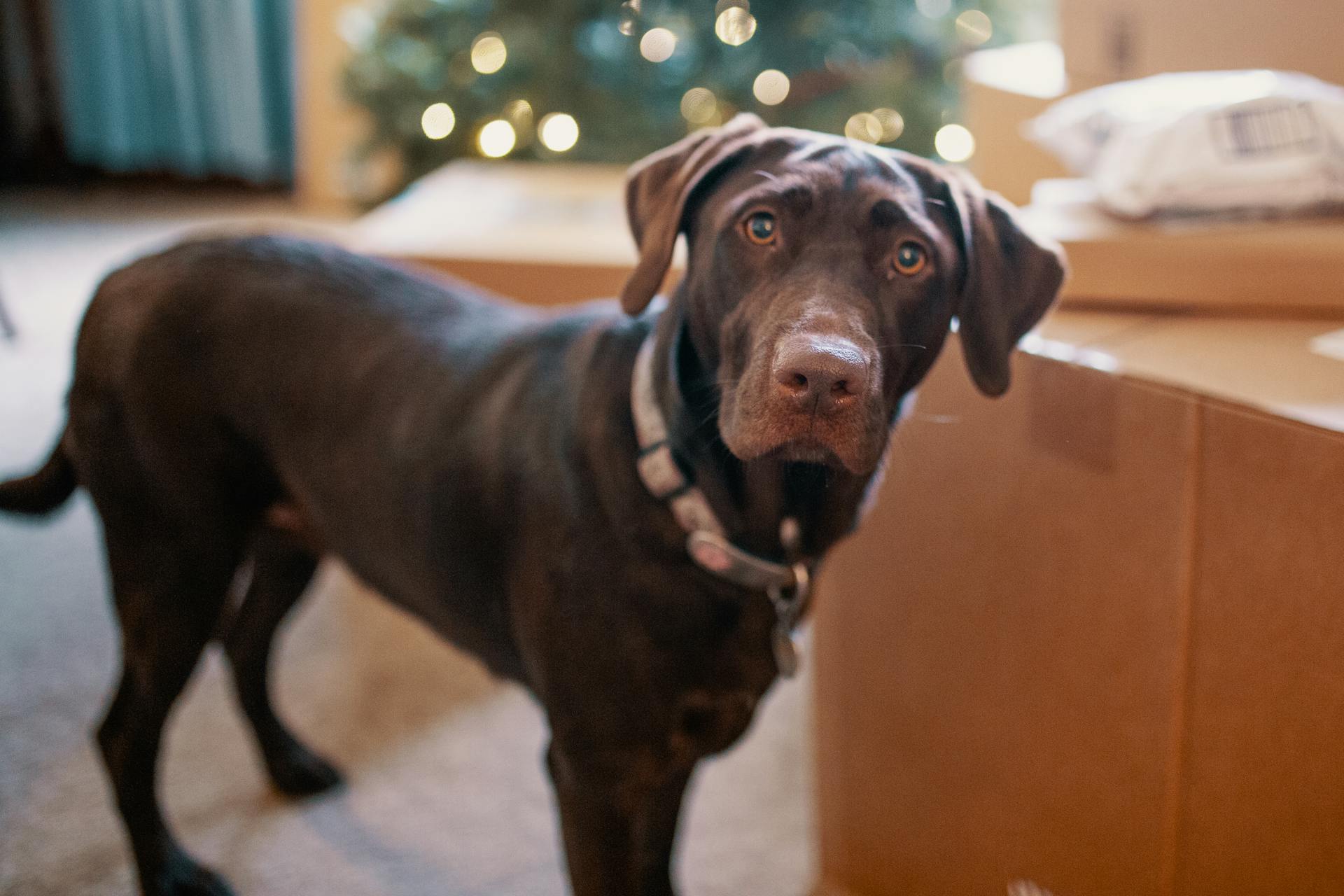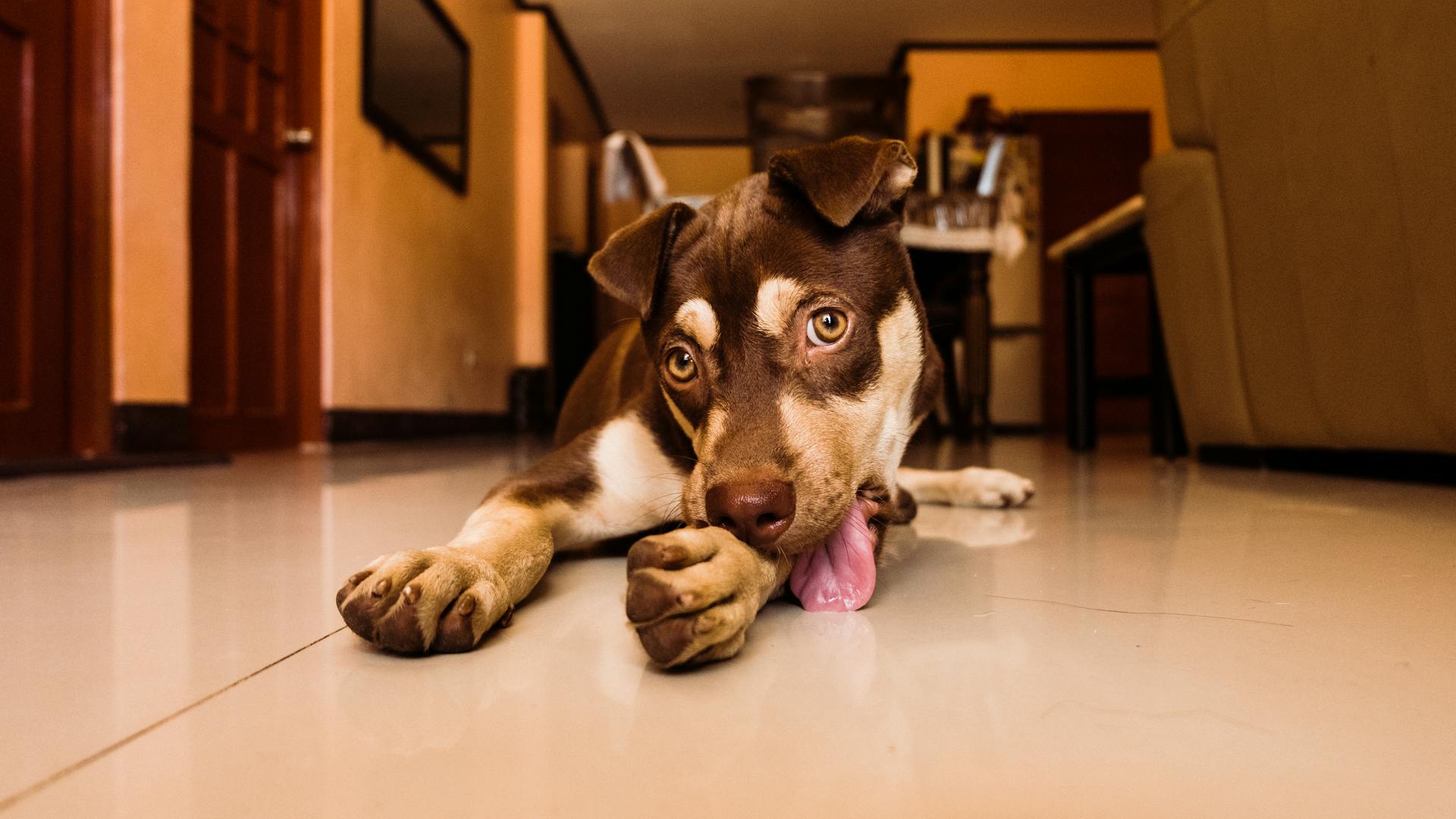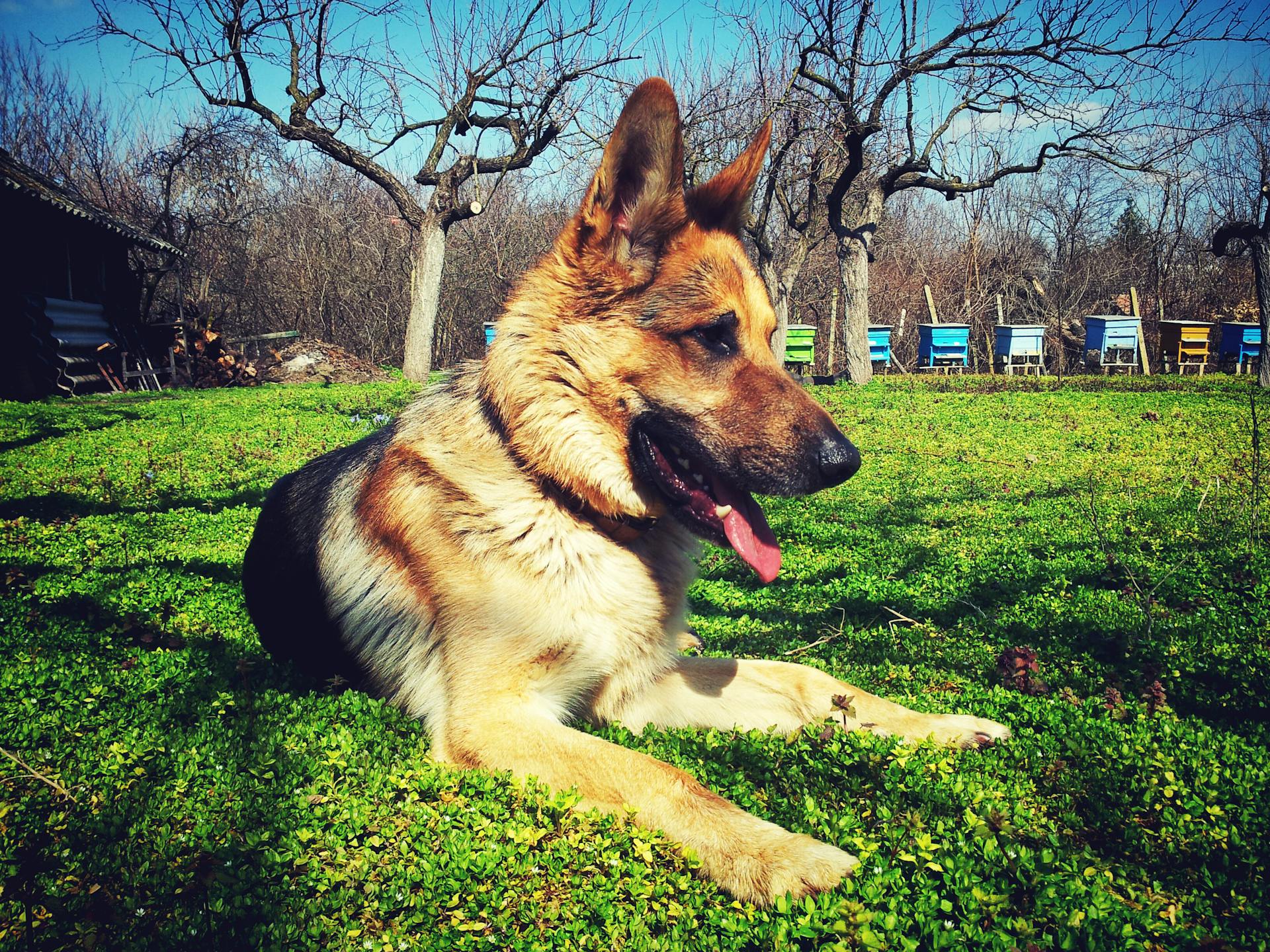
Packing peanuts can be a choking hazard for dogs, and if ingested, they can cause intestinal blockages or obstruction.
A single pound of packing peanuts can contain up to 70,000 individual peanuts, which can add up quickly and pose a significant risk to your dog's health.
The small size of packing peanuts makes them easy to swallow, and if your dog ingests a large amount, it can lead to a life-threatening situation.
If your dog has eaten packing peanuts, it's essential to monitor their behavior closely for signs of distress, such as vomiting, diarrhea, or lethargy.
Consider reading: Dogs Eating Peanuts
Choking Emergencies
Choking emergencies can be terrifying, but knowing what to do can help save your dog's life. If your dog is choking on packing peanuts or any other object, look out for signs like coughing, having trouble breathing, gasping for air, pawing at their face, excessive drooling, or acting panicked.
A dog can lose consciousness and their gums can change from a normal pink hue to a blue or white color if they're choking. If you see these symptoms, it's an emergency.
If you're alone with your dog, try to call out for help so someone can call a nearby veterinary clinic or give you a ride to the nearest hospital. Having someone assist you can be a huge help in an emergency situation.
If you want to attempt to remove the object from your dog's mouth, be careful not to get bitten or push the item further back into their throat. You can try pulling their tongue out towards yourself and using your hand to carefully pull out the object.
Alternatively, you can open your dog's mouth and use sweeping motions with your fingers to grab the item and pull it outward. If you have tweezers or tongs, you can try using those to attempt to remove the object.
If these attempts don't work, you'll need to perform the Heimlich Maneuver and CPR to save your dog's life.
Packing Peanuts Safety
Packing peanuts can be a choking hazard for dogs, especially if they're small and eat a large quantity.
Traditional packing peanuts made of polystyrene are a problem if eaten by a dog, but biodegradable packing peanuts made of corn starch are non-toxic and dissolve in water.
However, biodegradable packing peanuts can still cause an upset stomach in dogs.
The size of your dog and the quantity of packing peanuts eaten play a big role in determining the severity of the problem.
If your dog eats a small amount of biodegradable packing peanuts, the likelihood of a problem is much less present.
But if your dog eats a large quantity of non-biodegradable packing peanuts, it can lead to a foreign body obstruction, which is a medical emergency.
Signs of a foreign body obstruction or gastrointestinal issue due to packing peanut consumption include continual vomiting, not wanting to eat, a painful abdomen, lethargy, weakness, or depression.
If you suspect your dog has eaten packing peanuts, it's essential to seek treatment promptly, as the longer a dog is sick, the more likely they can have complications or an unfavorable outcome.
Treatment options may include radiographs, endoscopy, or surgery, depending on the situation and your veterinarian's guidance.
With early treatment and successful removal of the obstruction, dogs can have a good outlook and a favorable prognosis.
What to Do If Your Pet Has Eaten Something
If your pet has eaten something they shouldn't have, it's essential to act quickly and carefully. If your dog has eaten packing peanuts, a common component of Styrofoam, monitor them closely for symptoms.
Panting, shaking, and lethargy are often the first signs of an issue, and they can happen immediately if your pet is experiencing an adverse reaction. These symptoms may be focused on the stomach, but they will be sudden.
If your pet is showing signs of distress, such as panting, shaking, or lethargy, get them to a vet as soon as possible. The sooner you act, the better.
If your pet is eating undigestible items like Styrofoam, smaller amounts are likely to pass through with no major issues in large breed dogs. However, small breed dogs and puppies are at a higher risk of intestinal blockage.
In cases of suspected toxicity or obstruction, it's crucial to get your pet to the vet immediately. Visible bloating, no appetite, and being unable to go to the bathroom are all signs that require urgent attention.
Here's a list of steps to take if you suspect your pet has eaten something they shouldn't have:
- Call your vet and get their advice
- Get information on what your pet ate
- Monitor your pet for symptoms
Symptoms and Prevention
Symptoms of packing peanut ingestion in dogs can be quite unpleasant, including nausea, diarrhea, vomiting, lack of appetite, abdominal pain and swelling, and lethargy. If you notice any of these symptoms in your furry friend, it's best to err on the side of caution and call the vet right away.
The trash can is a common access point for dogs, especially if it contains meat juice on a Styrofoam tray. Try using a pet-secure trash can or keeping it safely secured away from your furry friends to prevent them from getting into trouble.
Here are some signs to watch for if your dog has eaten dissolvable packing peanuts or styrofoam:
- Nausea
- Diarrhea
- Vomiting
- Lack of appetite
- Abdominal pain & swelling
- Lethargy
- Panting
- Shaking/trembling
- Retching or vomiting
- Signs of distress
- No appetite
- Visible bloating
- Unable to go to the bathroom
Symptoms After Eating
If your dog has eaten something it shouldn't have, like packing peanuts or styrofoam, it's essential to know the symptoms to watch out for.
Nausea, diarrhea, vomiting, and lack of appetite are common symptoms of dissolvable packing peanut ingestion in dogs.
See what others are reading: Dog Ear Infection Packing

Diarrhea and vomiting can last longer than 24 hours, so it's crucial to monitor your dog's health closely.
If your dog has eaten styrofoam, you may notice panting, shaking, lethargy, retching or vomiting, signs of distress, no appetite, visible bloating, or an inability to go to the bathroom.
These symptoms can occur within minutes of eating the styrofoam, similar to an allergic reaction.
If your dog has eaten styrofoam, it's possible that pieces will pass through their system in 24-48 hours, but monitoring is still necessary to ensure no remaining pieces are causing a problem.
Here's a list of symptoms to watch for if your dog has eaten styrofoam:
- Panting
- Shaking/trembling
- Lethargy
- Retching or vomiting
- Signs of distress
- No appetite
- Visible bloating
- Unable to go to the bathroom
If you notice any of these symptoms, it's essential to get your dog to the vet as soon as possible.
In some cases, the vet may need to perform emergency surgery to safely remove the blockage from the dog's system.
In most cases, a dog that receives prompt medical care will make a full recovery, and if your dog has eaten one or two dissolvable packing peanuts, chances are they will be okay.
See what others are reading: Vet Dogs Dog Treats
Preventing

Preventing your dog from eating styrofoam is crucial to avoid potential harm.
To keep your dog away from styrofoam, keep them firmly under control in situations where styrofoam is common, such as building sites. This is a big part of being a responsible pet parent.
You can also prevent your dog from eating styrofoam by keeping all styrofoam out of sight and reach. This includes styrofoam packaging, toys, and even bean bags or bedding that contain polystyrene.
Monitor your dog when they're exploring new locations to prevent them from picking up litter like coffee cups or cupcake wrappers.
Some common areas where styrofoam can be found include packing meat trays, single-use coffee cups, plush toys, and even backpacks and sleeping bags. Keep these items out of sight and reach for your dog.
Here's a list of areas to watch out for styrofoam:
- Packing meat trays
- Single-use coffee cups
- Plush toys
- Bean bags or bedding
- Backpacks
- Sleeping bags
Taking care when opening packages and using pet-secure trash cans can also help prevent your dog from accessing styrofoam.
Prevention and Management
If your dog eats packing peanuts, a few things will come into play. The size of your dog, the number of packing peanuts consumed, and the type of material they're made of will all be crucial factors in determining the severity of the situation.
A small amount of biodegradable packing peanuts is unlikely to cause problems, but non-biodegradable peanuts are a different story. They can cause choking hazards, upset stomachs, or even become a foreign body obstruction.
If you notice any of the following signs in your dog, such as continual vomiting, not wanting to eat, a painful abdomen, lethargy, weakness, or depression, it's essential to seek treatment promptly. A foreign body obstruction is a medical emergency.
To prevent your dog from eating packing peanuts, try to keep them out of reach, especially when opening packages. This can be as simple as picking up any stray peanuts that may have fallen on the floor.
Soft toys with Styrofoam fillings and bean bags or bedding that contain polystyrene should be avoided, as they can be chewed up and swallowed. Consider using pet-secure trash cans or keeping them safely secured away from your furry friends.
Prevention is key, so it's crucial to supervise your dog when they're playing with toys or exploring their surroundings. Keep them on a leash when walking in public places to avoid them picking up litter.
By following these simple steps, you can significantly reduce the risk of your dog ingesting packing peanuts or Styrofoam. Remember, it's always better to be safe than sorry, and prompt treatment can make all the difference in the outcome.
If your dog does ingest non-biodegradable packing peanuts, follow your veterinarian's medical guidance. Depending on the situation, radiographs may be recommended, and in some cases, removal of the peanuts may require endoscopy or surgery.
By being proactive and taking steps to prevent packing peanut consumption, you can help ensure your dog's safety and well-being.
Discover more: What Can You Feed Dogs Instead of Dog Food
Toxicity and Risks
Most Styrofoam doesn't contain chemicals that are outright toxic to dogs, but it's not safe for them to eat.
The real danger is that Styrofoam can't be digested, which means it carries a risk of causing a blockage in your dog's gut, known as an intestinal obstruction.
A small amount of polystyrene, the type of plastic used to make Styrofoam, is usually not a cause for concern, especially if chewed up into small pieces or eaten by a large breed dog.
However, it's always best to seek professional veterinary advice if your dog ingested any amount of Styrofoam.
The chemical in Styrofoam, styrene, is not considered a carcinogen for animals, and a single exposure event is unlikely to cause cancer or major toxic effects on dogs.
But, styrene can still cause mild irritation to the mouth and gut if ingested.
Intriguing read: Merrick Dog Food for Small Dogs
Can Kill?
Yes, styrofoam can kill a dog. Many think that "just a few bits" is fine, but the reality is that it doesn't take much to cause a problem.
It can cause a blockage in your dog's gut (intestinal obstruction), which can be fatal. This is because canines cannot digest the plastic materials used to make styrofoam.
In some cases, styrofoam can also cause a choking hazard, which can be fatal if left unattended. A small amount of polystyrene may pass through the gut with no major concerns, but it's always best to seek professional veterinary advice if your dog ingested any amount.
Unfortunately, yes, styrofoam is a choking hazard for dogs and can cause intestinal obstruction, both of which can be fatal.
What Chemical Is Toxic?
Styrofoam contains a chemical called styrene, which can cause mild irritation to the mouth and gut if ingested.
Styrene is known to be an irritant to the skin, eyes, and lungs during manufacture.
A single exposure event to styrene is extremely unlikely to cause cancer or any major toxic effects on dogs.
There is little reason to believe that styrene is a carcinogen for animals, according to the WHO consensus.
While styrene is not toxic in the final products we use daily, it's essential to remember that Styrofoam is not meant to be eaten.
Mild irritation to the mouth and gut is possible if a dog ingests Styrofoam containing styrene.
Frequently Asked Questions
What happens if a dog eats a little bit of styrofoam?
If a dog eats a small amount of Styrofoam, it's unlikely to cause permanent damage, but it's still a concern due to potential choking hazards and digestive issues. However, it's essential to monitor your dog's health closely after ingestion.
What happens when a dog eats a styrofoam peanut?
Eating a Styrofoam peanut can lead to vomiting, but in severe cases, it may require a vet visit and costly treatment for your dog
Sources
- https://www.hepper.com/my-dog-ate-packing-peanuts-what-to-do-vet-answer/
- https://www.caninejournal.com/dog-ate-styrofoam/
- https://www.hepper.com/my-dog-ate-styrofoam-what-to-do-vet-answer/
- https://ourfitpets.com/health/digestive-system/my-dog-ate-dissolvable-packing-peanuts-what-should-i-do/
- https://dogadvisorycouncil.com/dog-ate-styrofoam/
Featured Images: pexels.com


